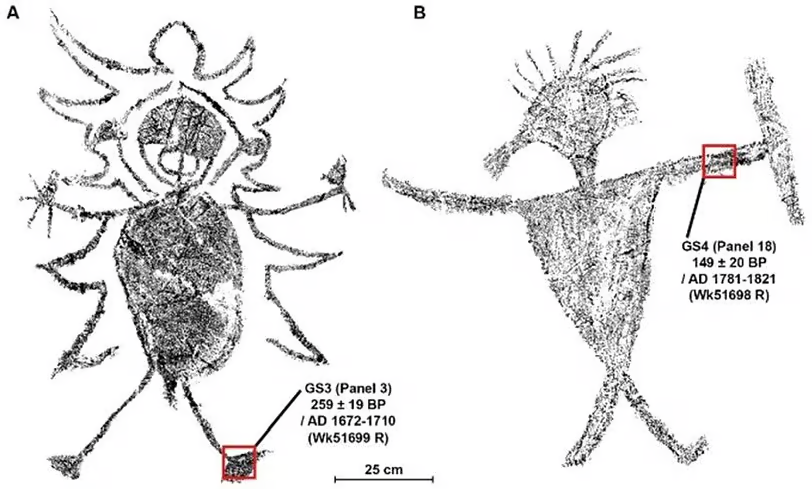Many of the hundreds of drawings of humans found in the Gua Sireh cave in Sarawak, Malaysia, appear to be caught up in violent fights.
The dated rock art. Credit: Andrea Jalandoni
The drawings' provenance has been verified by carbon dating by an international team of archaeologists.
The images were created during the 17th and 19th centuries, coinciding with a rise in hostilities between the indigenous residents of the area, such as the Bidayuh people, and the invading Malay aristocracy.
The team of archaeologists from Australia, Malaysia, and New Zealand believes this is the first time radiometric dating has been used to determine the age of Malaysian rock art.
Professor Paul Tacon, an archaeologist at Griffith University and co-author of a study explaining the discovery that was published in PLOS One, says that it is difficult to date rock globally.
Mohammad Sherman Sauffi William from the Sarawak Museum and Jillian Huntley harvesting sample GS3. Credit: Paul S.C. Taçon.
Although radiocarbon testing can estimate an object's age to be as old as 50,000 years, most pigments, such as the red that served as the foundation for many Malaysian cave paintings, don't contain carbon.
"The paintings that are black, if they were made with charcoal, they could potentially be directly dated," explains Tacon.
According to Tacon, there are "quite a number" of sites with black drawings throughout Peninsular Malaysia, as well as a few in the Malaysian states of Sarawak and Sabah on the island of Borneo.
The designs resemble those that have been discovered in the Philippines and Sulawesi, where some have been dated to 3,500 and 1,500 years ago, respectively.
Infographic showing the dated rock art. Digital tracing and design by Lucas Huntley
Since they don't want to inflict even minor harm to it, Tacon adds that it might be challenging to obtain a permit to sample the art in several places where she has been researching it alongside Malaysian archaeologists for the past 14 years.
To take small samples from Gua Sireh, Tacon and his colleague Mohammad Sherman Sauffi William, curator of the Sarawak Museum Department, obtained a study authorization. The cave has been inhabited by mankind for at least 20,000 years, according to additional evidence.
These examples demonstrated to them that the images' production dates, which correspond to the area's frontier violence, were between 1670 and 1830.
According to Tacon, "there are figures holding what appear to be fighting swords."
"Many of these lesser figures surround some of these larger ones. Additionally, we know from history and ethnography that the paintings we've identified as being from a time of intense conflict between Malay elites and the indigenous Bidayuh people and the Iban people who lived along the beaches.
As a result, "the iconography, the images, and the dates we have fit exactly with the historical record of frontier violence at that time."
William, a Bidayuh descendent, claims that this data also accords with the Bidayuh people's oral history.
The dated rock art at Gau Sireh alongside micrographs of the bamboo charcoal used to draw them. Credit: Huntley et al., 2023, PLOS One, https://doi.org/10.1371/journal.pone.0288902
He claims that during territorial conflict in the early 1800s, when a very strict Malay Chief demanded that they hand over their children, the Bidayuh used Gua Sireh as a haven.
They declined and withdrew to Gua Sireh, where they at first successfully repelled a party of 300 armed men who were attempting to enter the cave from a valley approximately 60 meters below.
The majority of the tribe managed to escape by a corridor at the back of the largest entry chamber that extends hundreds of meters through the Gunung Nambi limestone hill despite suffering some losses (two Bidayuh were shot and seven were captured and sold into slavery). However, they were able to save their children.
Two short-bladed Parang Ilang, the primary weapons used during combat that marked the first decades of white dominance in Borneo, as well as a Pandat, which was used only for battle or protection, were sketched alongside the figures.










